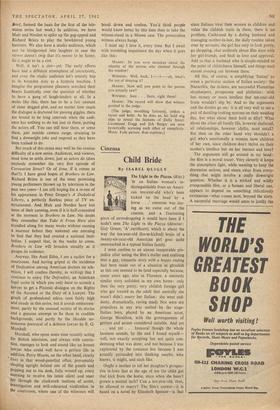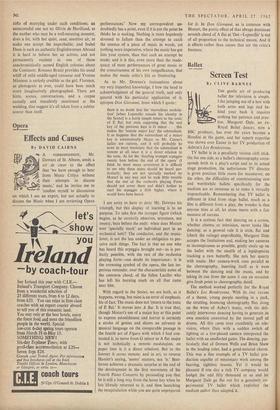Cinema
Child Bride
By ISABEL QUIGLY
The Light in the Piazza. (Ritz.) 'IF an Italian woman's in- / distinguishable from an Ameri- can ten-year-old who's been kicked on the head by a horse . . .' someone was say- ing as we came out of the cinema; and a fascinating piece of eavesdropping it would have been if I hadn't seen The Light in the Piazza (director: Guy Green; 'A' certificate), which is about the way the ten-year-old (horse-kicked) brain of a twenty-six-year-old American girl goes quite unremarked in a typical Italian family.
I must confess to an almost insuperable pre- judice after seeing the film's trailer and realising that a gay, romantic story with a happy ending had been made out of a situation as ghoulish as this one seemed to be (and especially because, some years ago, also in Florence, a sinisterly similar story unfolded in my own home: only then the very pretty, very childish foreign girl who got treated as the adult that mentally she wasn't didn't marry her Italian : she went sud- denly, dramatically, raving mad). Nor were my prejudices in any way melted by the stage- Italian hero, played by an American actor, George Hamilton, with the grotesqueness of gesture and accent considered suitable. And yet . . . and yet . . . Immoral though the whole business sounds, by the end I found myself— well, not exactly accepting but not quite con- demning what was done; and not because 1 was captivated by the romance but because I was actually persuaded into thinking maybe, who knows, it might, and such like.
Ought a mother to tell her daughter's prospec- tive in-laws that at the age of ten the child got that kick from the horse, since when she hasn't grown a mental inch? Can a ten-year-old, then, be allowed to marry? The film's answer—it is based on a novel by Elizabeth Spencer—is that since Italians treat their women as children and value the childish traits in them, there is no problem. Cushioned by a doting husband and managing mother-in-law, the daily routine taken over by servants, the girl has only to look pretty, go shopping, chat endlessly about film stars with her girl-friends, and bask in love and approval. Add to that a husband who is simple-minded to the point of childishness himself, and things start almost evening out between them.
All this, of course, is simplifying 'Italian' to mean a particular section of Italian society: the Nacarellis, the in-laws, are successful Florentine shopkeepers, prosperous and philistine: with less money or more intellect that ten-year-old brain wouldn't slip by. And so the arguments and the doubts go on: it is all very well to see a pair of dazzling-looking morons on their wedding day, but what about them both at fifty? What about the crises all family life, however sheltered, all relationships, however idyllic, must entail? But then on the other hand why shouldn't a girl who's emotionally a woman have children of her own, since children don't thrive on their mother's intellect but on her instinct and love?
The arguments still go around in my head: the film is a moral teaser. Very cleverly it keeps the atmosphere light, while seeming to keep the discussion serious, and steers away from every- thing that might involve a really downright question. Whether it is a wicked and wildly irresponsible film, or a human and liberal one, appears to depend on something ridiculously extraneous—what comes next, beyond the story. A successful marriage would seem to justify the risks of marrying under such conditions; an unsuccessful one not to. Olivia de Havilland, as the mother who may be a well-meaning monster, does a lot, with her quiet, sane; sensitive air, to make one accept the improbable; and Isabel Dean is such an authentic Englishwoman Abroad it is hard to believe her an actress, and not permanently resident in one of those anachronistically named English colonies about the Continent. Rossano Brazzi provides his usual whiff of mild middle-aged romance and Yvonne Mimieux is entirely credible as the girl. Florence, as photogenic as ever, could have been much more imaginatively photographed. There are hints, scenes, conversations, and a corpse casually and macabrely mentioned at the wedding, that suggest it's all taken from a subtler source than itself.















































 Previous page
Previous page